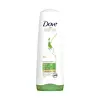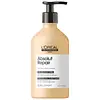What's inside
What's inside
 Key Ingredients
Key Ingredients

 Benefits
Benefits

 Concerns
Concerns

 Ingredients Side-by-side
Ingredients Side-by-side

Water
Skin ConditioningCetearyl Alcohol
EmollientStearamidopropyl Dimethylamine
EmulsifyingDimethiconol/Silsesquioxane Copolymer
Skin ConditioningParfum
MaskingBehentrimonium Chloride
PreservativeIsohexadecane
EmollientGlycerin
HumectantDipropylene Glycol
HumectantLactic Acid
BufferingCitric Acid
BufferingSodium Gluconate
Skin ConditioningSodium Chloride
MaskingDisodium EDTA
Sodium Citrate
BufferingCetrimonium Chloride
AntimicrobialVitis Vinifera Seed Oil
EmollientCocos Nucifera Oil
MaskingHydrolyzed Soy Protein
HumectantMethylchloroisothiazolinone
PreservativeMethylisothiazolinone
PreservativeBenzyl Salicylate
PerfumingCitronellol
PerfumingHexyl Cinnamal
PerfumingLimonene
PerfumingLinalool
PerfumingCI 19140
Cosmetic ColorantCI 17200
Cosmetic ColorantWater, Cetearyl Alcohol, Stearamidopropyl Dimethylamine, Dimethiconol/Silsesquioxane Copolymer, Parfum, Behentrimonium Chloride, Isohexadecane, Glycerin, Dipropylene Glycol, Lactic Acid, Citric Acid, Sodium Gluconate, Sodium Chloride, Disodium EDTA, Sodium Citrate, Cetrimonium Chloride, Vitis Vinifera Seed Oil, Cocos Nucifera Oil, Hydrolyzed Soy Protein, Methylchloroisothiazolinone, Methylisothiazolinone, Benzyl Salicylate, Citronellol, Hexyl Cinnamal, Limonene, Linalool, CI 19140, CI 17200
Water
Skin ConditioningCetearyl Alcohol
EmollientDicetyldimonium Chloride
EmulsifyingCetrimonium Chloride
AntimicrobialDimethicone
EmollientCetyl Esters
EmollientSodium Benzoate
MaskingIsopropyl Alcohol
SolventAmodimethicone
Linalool
PerfumingTrideceth-10
CleansingTartaric Acid
BufferingHexyl Cinnamal
PerfumingChlorhexidine Digluconate
AntimicrobialLimonene
PerfumingPEG-100 Stearate
Phenoxyethanol
PreservativeSteareth-6
EmulsifyingTrideceth-3
EmulsifyingChenopodium Quinoa Seed Extract
Skin ConditioningCI 19140
Cosmetic ColorantAcetic Acid
BufferingHydroxypropyltrimonium Hydrolyzed Wheat Protein
Skin ConditioningTrisodium Hedta
CI 17200
Cosmetic ColorantParfum
MaskingWater, Cetearyl Alcohol, Dicetyldimonium Chloride, Cetrimonium Chloride, Dimethicone, Cetyl Esters, Sodium Benzoate, Isopropyl Alcohol, Amodimethicone, Linalool, Trideceth-10, Tartaric Acid, Hexyl Cinnamal, Chlorhexidine Digluconate, Limonene, PEG-100 Stearate, Phenoxyethanol, Steareth-6, Trideceth-3, Chenopodium Quinoa Seed Extract, CI 19140, Acetic Acid, Hydroxypropyltrimonium Hydrolyzed Wheat Protein, Trisodium Hedta, CI 17200, Parfum
Ingredients Explained
These ingredients are found in both products.
Ingredients higher up in an ingredient list are typically present in a larger amount.
Cetearyl alcohol is a mixture of two fatty alcohols: cetyl alcohol and stearyl alcohol. It is mainly used as an emulsifier. Emulsifiers help prevent the separation of oils and products. Due to its composition, it can also be used to thicken a product or help create foam.
Cetearyl alcohol is an emollient. Emollients help soothe and hydrate the skin by trapping moisture.
Studies show Cetearyl alcohol is non-toxic and non-irritating. The FDA allows products labeled "alcohol-free" to have fatty alcohols.
This ingredient is usually derived from plant oils such as palm, vegetable, or coconut oils. There is debate on whether this ingredient will cause acne.
Due to the fatty acid base, this ingredient may not be Malassezia folliculitis safe.
Learn more about Cetearyl AlcoholThis ingredient is a preservative, antimicrobial, and emulsifier. It is often used in cosmetics for its ability to cleanse, condition, and reduce static.
Cetrimonium chloride is a quaternary ammonium salt, meaning it has a water-soluble structure.
Ci 17200 is a synthetic reddish-purple dye.
CI 19140 is also known as Tartrazine. Tartrazine is a synthetic dye used in cosmetics, foods, and medicine to add a yellow color.
Tartrazine is created from petroleum and is water-soluble.
Some people may experience allergies from this dye, especially asthmatics and those with an aspirin intolerance.
Learn more about CI 19140Hexyl Cinnamal is a fragrance ingredient with a similar scent to jasmine. It can be naturally found in chamomile essential oil.
This ingredient is a known EU allergen and may sensitize the skin. The EU requires this ingredient to be listed separately on an ingredients list.
Hexyl Cinnamal is not water soluble but is soluble in oils.
Learn more about Hexyl CinnamalLimonene is a fragrance that adds scent and taste to a formulation.
It's found in the peel oil of citrus fruits and other plants such as lavender and eucalyptus. The scent of limonene is generally described as "sweet citrus".
Limonene acts as an antioxidant, meaning it helps neutralize free radicals.
When exposed to air, oxidized limonene may sensitize the skin. Because of this, limonene is often avoided by people with sensitive skin.
The term 'fragrance' is not regulated in many countries. In many cases, it is up to the brand to define this term. For instance, many brands choose to label themselves as "fragrance-free" because they are not using synthetic fragrances. However, their products may still contain ingredients such as essential oils that are considered a fragrance.
Learn more about LimoneneLinalool is a fragrance and helps add scent to products. It's derived from common plants such as cinnamon, mint, citrus, and lavender.
Like Limonene, this ingredient oxidizes when exposed to air. Oxidized linalool can cause allergies and skin sensitivity.
This ingredient has a scent that is floral, spicy tropical, and citrus-like.
Learn more about LinaloolParfum is a catch-all term for an ingredient or more that is used to give a scent to products.
Also called "fragrance", this ingredient can be a blend of hundreds of chemicals or plant oils. This means every product with "fragrance" or "parfum" in the ingredients list is a different mixture.
For instance, Habanolide is a proprietary trade name for a specific aroma chemical. When used as a fragrance ingredient in cosmetics, most aroma chemicals fall under the broad labeling category of “FRAGRANCE” or “PARFUM” according to EU and US regulations.
The term 'parfum' or 'fragrance' is not regulated in many countries. In many cases, it is up to the brand to define this term.
For instance, many brands choose to label themselves as "fragrance-free" because they are not using synthetic fragrances. However, their products may still contain ingredients such as essential oils that are considered a fragrance by INCI standards.
One example is Calendula flower extract. Calendula is an essential oil that still imparts a scent or 'fragrance'.
Depending on the blend, the ingredients in the mixture can cause allergies and sensitivities on the skin. Some ingredients that are known EU allergens include linalool and citronellol.
Parfum can also be used to mask or cover an unpleasant scent.
The bottom line is: not all fragrances/parfum/ingredients are created equally. If you are worried about fragrances, we recommend taking a closer look at an ingredient. And of course, we always recommend speaking with a professional.
Learn more about ParfumWater. It's the most common cosmetic ingredient of all. You'll usually see it at the top of ingredient lists, meaning that it makes up the largest part of the product.
So why is it so popular? Water most often acts as a solvent - this means that it helps dissolve other ingredients into the formulation.
You'll also recognize water as that liquid we all need to stay alive. If you see this, drink a glass of water. Stay hydrated!
Learn more about Water